#GM tool
Explore tagged Tumblr posts
Text
On The Radar -- Monstrous by CloudCurio
Project Title: Monstrous
Format: PDF/Hardcover
Campaign Start: September 5th, 2023
Campaign End: October 5th, 2023
Campaign Goal: $75,000 (Current Pledge Amount: $75,458) Campaign Team Size: 4 --- --- --- Project Info: So, what exactly is Monstrous about? – It’s a Friday night. Your players—after a failed stealth roll triggered an undead swarm—are barely able to stand after a grueling combat encounter. They stand before slowly opening, once ornate doors that will lead them into the throne room of Kras Maza, The Lich of Endless Night. You look at your players slowly, your head lurching at the table like an owl searching for prey. You begin to play the mixtape of ominous whispers and Gregorian chanting, you pull out the dice tower of death, and ask your players one question. “Are you ready to see Death’s real face?”. You know that the lich you’ve made for your players will stay with them long after the campaign’s end and it's all thanks to Monstrous. A tome that might be your newest best friend in the field of monster creation for your campaigns. With 10 core monsters, 30 monster forms, immaculate vibes, and tables waiting to just spice things up. Monstrous intends to be a ghoulish little thing that offers up new ways to approach monsters and how they work within your campaign setting. Okay, I’m interested but isn’t this just like any other 1st or 3rd party supplement? – That’s an entirely fair question. There’s a variety of supplements out there in the TTRPG world that try to remix, change, or shift things up with monsters. But Monstrous isn’t just another supplement that has traditional TTRPG monsters in a different art style, stat blocks intended for one system, and GM tidbits on how to best use the monster et cetera. To quote one of its preview pages, Monstrous as a book wants to “bring fear, wonder, and mystery back to monsters” along with also “demystifying” the process that goes into writing/creating monsters. What exactly does that mean though? Well, it means that Monstrous wants to make the action of monster creation a more involved process for the GM. It wants to give the GM tools that they can use to make a monster that feels unique and interesting for a campaign. And Monstrous does that through some of the following: microfiction to introduce the monster, brief exploration of the monster’s goals/presence in the world, fill in the blank style generation, and inspiration tables to give extra spice. What exactly is in Monstrous? – All right, so, Monstrous is divided up into chapters that focus on 10 specific monsters. With each of these chapters going over the following: Core, Core Abilities, Forms, and Inspiration Tables. Firstly, there is the Core of the monster. This gives a brief exploration of the monster and their place within the campaign setting. Basically, this section is intended to provide an approach to the monster and their potential use in a session. Secondly, there is the Core Abilities of the monster. Which is a fill in the blank section that allows for a great degree of customization in the abilities/powers of the monster, and also depending on the monster. Their goals and motivations Thirdly, there are the Forms of the monster and they can be considered as an archetype of monster. Each chapter comes with forms of three predesigned, statless monsters that can be used with existing or entirely homebrewed stat blocks.
And finally, there are the Inspiration Tables. Pretty self explanatory, really, they’re tables that offer rumors, signs, potential lairs, and names for each monster. Besides these four sections, each monster also comes with a full page illustration and microfiction that gives flavor to set the mood. --- --- --- --- --- --- Campaign Info: What’s the campaign funding? – The campaign for Monstrous is funding the following: design, editing, graphic design, project management, planning/logistics, labor, shipping/packing. Along with that, the campaign funds will also be used to cover various fees and production costs for Monstrous. The campaign page also has a detailed breakdown of where the funds will go upon completion of funding, and I like that because it shows how serious Cloud Curio is with backer transparency. Are there shipping costs? – Yes, there are shipping costs. US backers will have to pay $15 while international backers will have to pay $30. Besides the shipping costs, Cloud Curio will not be collecting/remitting VAT, other shipping fees, or taxes for international backers. International backers will be responsible for any fees upon receiving their package. When will Monstrous come out? – Monstrous will come out respectively in May 2024 (PDF) and July 2024 (Hardcover). If I miss the campaign can I still get Monstrous? – Absolutely! Cloud Curio will have pre-orders from January 1st to March 1st of 2024 on their Etsy store for anyone who missed out on the campaign. The following items that will be available for pre-order are: regular/special edition copies, tarot deck, and unlocked kickstarter freebies. --- --- --- --- --- --- Pledge Info: * (Note: When funded all physical reward tiers for Monstrous will be given three stickers/three prints for free. For backers outside of the US, make sure you pick the “International” version of a pledge level; Merchant’s Ware pledge is for US merchants only.) • Goblin’s Cache ($20) – Pledgers at this level get the form fillable PDF copy of Monstrous.
• King’s Treasury ($45) – Pledgers at this level get the regular edition hardcover copy and form fillable PDF copy of Monstrous.
• Wizard’s Collection ($75) – Pledgers at this level get the special edition (clothbound, gold-foil) hardcover copy and form fillable PDF copy of Monstrous. • Dragon’s Hoard ($95) – Pledgers at this level get the special edition (clothbound, gold-foil) hardcover copy and the form fillable PDF copy of Monstrous. Additionally, pledgers will also get a 40 card tarot deck. • Merchant’s Ware ($175||Note: This pledge is intended only and only for retailers. You will be asked for proof that you’re pledging for a brick-and-mortar store) – Pledgers at this level will get three regular edition copies and three special edition copies of Monstrous. --- --- --- --- --- --- Stretch Goals: • Book Upgrades! ($76,000) – This will result in more art being created for Monstrous and expands the book’s pages to 96. Along with that, the regular edition will receive a spot varnish while the special edition gets a dust jacket • Freebies! ($77,000||Wizard’s Collection and Dragon’s Hoard only) – The Wizard’s Collection and Dragon’s Hoard pledge levels will get an additional three stickers and three prints for free. Which means along with the free stickers/prints given to all physical pledge levels for Monstrous being fully funded, pledges at this level will get a total of six stickers and six prints for free. Add-ons: * (Note: The only add-ons being offered by the campaign are just additional copies of either the regular or special edition of Monstrous. This is being done in order to provide the campaign team an easier time with managing campaign orders). • Additional Monstrous copy ($45/$75 respectively depending on edition chosen) – An extra copy of either the regular or special edition of Monstrous. --- --- ---
(Thank you reading this latest installment of On The Radar! I hope you have a good day! P.S. If you know any projects that you would like to see get Radar coverage then feel free to comment below. ^_^)
6 notes
·
View notes
Text
Battle Sounds!
I added sounds! Honestly, i thought it would take me longer #FabulaUltima#CampaignTool#TTRPG#Godot
I forget how the much impact the little things have
youtube
View On WordPress
1 note
·
View note
Text
csp mini guide: edge eraser!
@lunasun hihi!! i tried to make an visual and wrote an explanation i hope this makes sense but if not then i failed LOL i hope you don't mind the tag
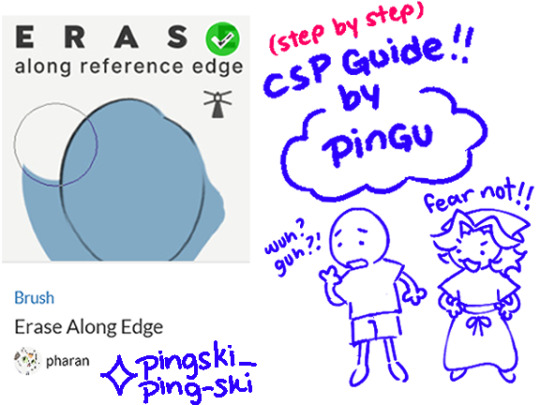




Erase Along Edge (Edge Eraser) text version!
1. Sketch or line as normal on one layer. 2. On a separate layer, below the lineart, color as normal. 3. Return to the lineart layer, and set it as the "Reference Layer". (Toggle ON by clicking on the lighthouse icon!) 4. Return to the color layer, select the "Erase Along Edge" tool, and erase the offending overlap! Aaand then you're done! Try stick to the outside of your lineart to avoid accidently erasing what's inside. As long as your brush size is reasonable, it shouldn't erase what's inside too much or at all unless if your cursor is inside of the lineart!
Quick Troubleshoot
"It won't erase properly?" "My lines aren't opaque and/or is too messy." That's OK!! While I do recommend solid lines (few gaps or none) or opaque lines (at 100% opacity), it's NOT necessary! It just makes using the tool easier! Most of the time you can get away with it, so don't worry about having to change your style or anything. If the lines are not solid (have gaps) or aren't opaque (lower than 100% opacity), please refer to the tool properties/settings! You may need to experiment here. Adjust the "Tolerance" and "Area Scaling" settings and repeat the process until you reach your desired result! Please note: If lines intercept (creating small "pockets) or opacity is still an issue you may have to manually erase anyways (sorry lol). By all means, it isn't perfect BUT it is a BIIIGG time saver once you have it down! The creator (pharan) makes more specific points and fixes in their guide that is far more in depth! I just want this to be easy to understand for anyone who's never used it before or is trying it for the first time! :)
#clip studio paint#csp ex#csp pro#fnaf daycare attendant#dca fandom#moondrop#pingdoobles#god i HOPE this makes sense#please tell me if it doesn't!!!#im not used to making guides or anything and i DO NOT claim to be a professional#im also happy to answer more questions or help further explain if there's still confusion!#ok i need to sleep i have to work and it's almost 6am awkughaw#will make a 2nd guide on the lasso fill tool “ice cream man” thing sometime l8r#idk when later is but at some point#my eyes are drooping while i type god#i am the eeper gn!! (or gm??)
160 notes
·
View notes
Text
Get your inns, taverns, pubs, and alehouses here!
You all meet up in an inn. But what's the inn like? What's it called? What can you do there? And how do I satisfy my players' unending appetite for entertainingly-named inns?
This generator has your answer. It will give you a name, a brief description including reputation and proprietor, and optional entertainments and encounters. Or you can generate a name and do the rest yourself!
Here's some names:
The Shirking Eagle
The Flea's Head
The Void on the Bridge
The Wrestler and Newt
The Mouse House
The Sheep's Serpent
The Honourable Eel
The Spectacles and Sword
The Bald Orb
The Smiths
The Toad on the Dragon
The Fighting Magpie's Arms
57 notes
·
View notes
Video
youtube
The Lancer Map Creation Tool by Interpoint Station is a program that lets you create complex yet readable battlefields in minutes, featuring a random generator to generate a map in seconds as well as assets integration to create your own terrain asset and biome.
174 notes
·
View notes
Text
hoho! art thou making battle maps? fantasy world cartography, perchance?
forgotten adventures has +120 000 high resolution assets [11 GB] available to download for free on their website!
frequent user of dungeon draft? they have +30 000 free objects available on their starter pack as well!
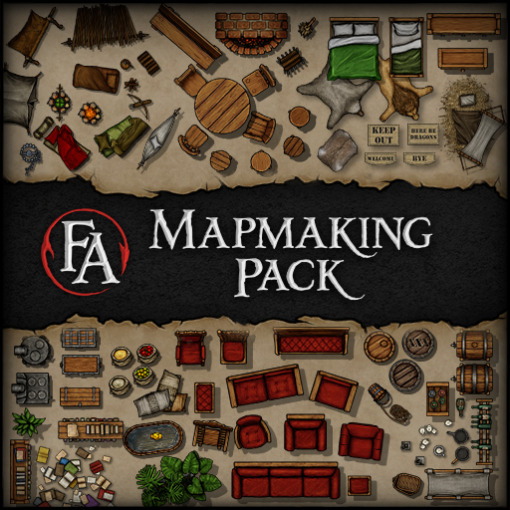
#websites#dnd#dm tools#tech tips#wizardblr#dnd maps#dnd resources#ttrpg#ttrpg community#pathfinder#worldbuilding#gm advice
145 notes
·
View notes
Text
Some astronomically unusual habitable worlds
Or, weird star systems that include a habitable planet, or at least one in the habitable band that could be terraformed, on the assumption that systems you can live in are more interesting than those that can't. "Habitability" is a bit of a stretch here; a habitable world could be anywhere from "it has an evolved biosphere with plants you can eat" to "an airless rockball, but if you pelt it with enough comets, put a biosphere in place, maybe you could eventually live there" or perhaps one where someone already did the hard part; that part is deliberately vague depending on how hard your sci-fi is.
Throw these on a d10 or 2d6 table or something; stick "planet orbiting a yellow dwarf" and "moon of a gas giant orbiting a yellow dwarf" in the most common spots, and you're good to go. This is a draft of a setting design generator table I might use. I might use it for Stars Without Number or I might use it to fill in stuff about under-developed systems in BattleTech, for instance. None of these have precursor aliens so that they can be used in settings that don't include them (if you add precursor space habitats to your star system tables, you can get pretty wild and I do fully encourage that), though one of them assumes humans have been at this space colonization thing for centuries. Likewise, this doesn't include anything that requires Weird Space Magic, like hollow worlds with an antigravitational inside and an inner pseudosun. If that exists in your setting and you're building a Weird Planets table then by all means put that in.
If you want to follow real astronomical commonality, small dim stars are much more common than big bright ones. I'm not an astrophysicist, though, and I haven't done the math to demonstrate that any of these are physically possible.
A world in a distant orbit around a bright star. Because luminosity increases with mass faster than gravity does, this world has a very long orbit; seasons might last decades. Depending on the role solar gravity plays in your setting's FTL (if any), these planets might be faster to reach coming out of FTL.
Converse to that, circumbinary planets (with two closely-orbiting stars at the center of the system) will have shorter years in the habitable band, since the mass is divided among two separate stars leading to much lower luminosity for the same mass
A world in a spread-out binary star system (the planet is closer to its primary than the other star is). The other star shines brightly on it. In the right time of year, there's never a night dimmer than a full moon.
A spread-out binary system with two separate habitable worlds, light-hours or light-days apart
A planet in a binary system with two stars of greatly different brightness, but because of relative distance they appear similar. It's tide-locked to the dimmer star, giving it an uninhabitable hot side and an inhabitable side with a day/night cycle.
A world in a highly eccentric orbit around an extremely bright star. In time, it will fall in to the inner system and its seas and atmosphere will boil away, but that's maybe a century or three out
That same world, coming out the other side. It might have scorched ruins on it, left behind when it was abandoned. It's on its way to the outer system, where it will freeze for a thousand years or more.
A planet that distantly orbits a black hole or neutron star, its atmosphere restored after the supernova burned it off. At the rate its primary is radiating (remnant heat/accretion disk), it's exactly in the habitable band, for now.
An outlying "moon" of a gas giant. Instead of orbiting its primary properly, it orbits at the L4 or L5 Lagrange point
A binary planet in a low orbit around a red dwarf. Their tidal forces on each other are the only thing that has kept them from becoming tide-locked to their primary.
57 notes
·
View notes
Text
Hey all, This is my first Tumblr post ever! I'm pretty new here, but I'm hoping to share some DM techniques, tools and tips and to make some new friends as well! Feel free to send a chat request (an ask[?]) if you're interested!
With that aside, on with the post!
Better and More Meaningful Random Encounters!
Random encounters are a staple of DnD, they are expected to be there during exploration as a way to make the world feel alive, to have it have an aura of adventure and danger, to eat up party resources and put pressure on the PCs to make interesting and important choices, and also as a way for a DM to reasonably 'stall' the party with a quick and easy situation.
Usually, it ends up something like this:
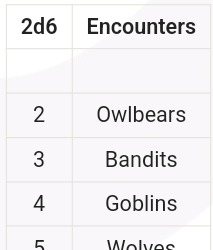
There's just one problem with most random encounter tables though, it's so easy for them to be GOSHDARN BORING! Especially for a newer DM.
Making them interesting becomes gambled improv on the DM's part if they're not used to it, and it's hard to keep track of the important factors that need to be kept in mind
Luckily, I ended up finding a great source for random encounters from 'Dungeon Masterpiece' on YouTube, and I integrated it into my own DMing. I figured that I'd share it here for any that want to work it into their own sessions as well!
After adjustment, a single table can account for multiple entire sessions of in-depth worldbuilding and fun without getting dull!
Sources:
Source 1 (Creating interesting Random Encounter Tables):
youtube
Source 2 (Making Random Encounters reflect your Worldbuilding):
youtube
There's 4 major methods we can use to improve the Random Encounter table
1. Make the table a straight 1dx roll.
2. Adding 'depth'.
3. Adding meaningful encounters.
4. Prerolling and/or Multirolling.
You can also check out the "Where to Start?" section for some direction to make getting it down and prepped all easy peasy!
1. Straight Roll:
Its enticing to go for 2d6 or the such in order to add non-linearity to the rolls, but these sorts of adjustments only end up making one or two encounters extremely likely and leave all others in the dust, it often ends up defeating it's own purpose of interesting randomness.
In the previous example, it was extremely likely to only get Wolves, Barbarians, Orcs, or Spiders, from a table of 12! A straight roll would serve us much better. The rare rolls are already rare enough as is!
Simply enough, adjusting the original example by replacing the 2d6 with 1d12, it'd become something more like this:
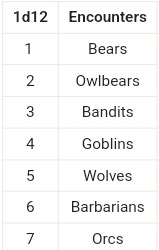
#2. Adding Depth:
We can add more columns in the encounter tables. These columns will represent different aspects about the encounters that we can roll on separately!
Usually it can be difficult as a DM to naturally come up with motives for the encounters, showcase the worldbuilding and have it all come together.
This setup can give you a solid guideline on how the creatures/people think (if any), and also sets up the overall area so that you get an idea of what events tend to occur there as a result of its occupants.
We want to add 3 more columns to the tables to convey different aspects of the encounter. Fill in these new columns corresponding to the expectations of each encounter.
We'll roll each of these and combine them, then we'll interpret them to make a robust, in-depth random encounter with truly unexpected results!
I recommend rolling alot of complete encounters at once and interpreting the context to the vast general area the party is travelling in.
i. Behaviour: How the creatures act. Are they friendly, scared, aggressive, curious, mischievous?
ii. Complication: Something behind the scenes in the encounter. Do they have sick young? Broken equipment? Are they starving?
iii. Significant Impact: This is a tick box, and will only be present under ONE of the rows. It will be rolled like the other columns, but ONLY once. It signifies which encounter is the Significant Encounter
The Significant Encounter will have its encounter's presence prominent amongst all the other random encounters in the area. There could be burn marks and carcasses from a rampant dragon, or a goblin raid leaving tracks moving through the area. Which is the most impactful of the different encounters?
Adding this to our previous example would expand it to:
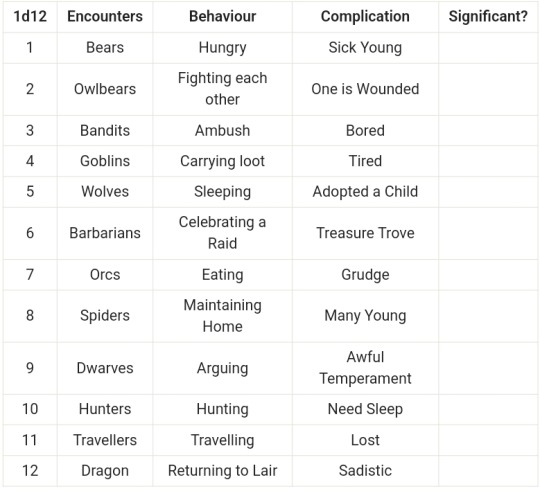
Rolling this would give us things like:
Significant encounter: Owlbears

Note that the significant impact shows that the Owlbears are a massive problem in the area. Perhaps the Owlbears are agitated for an unknown reason, and are unnecessarily aggressive.
The significance of Owlbears gives us context to the second one as well! Perhaps the hunters raided an Owlbear den, and adopted an Owlbear cub from there as well.
There could be uneaten carcasses, ravaged trees, less wildlife, etc around these parts.
Note how much sheer CONTEXT these columns add to our encounters. It's invaluable!
3. Adding Meaningful Encounters
Usually random encounters tend to be rather mundane and very one-note.
There's usually some general wildlife and monsters, different disparate factions without any rhyme or reason, and maybe a general non-combat encounter or two, but these don't really tell us about the area or its surroundings at all by themselves.
Instead, we can add in wildlife and monster encounters specific to the biome, non-combat encounters, and encounters of nearby factions and/or settlements to the table, and we can even add environmental encounters in there as well.
Note that we're not tied down to 12 encounters, and can expand it ad infinitum according to our need of diversity in our encounters.
Just add in specification and connection, and suddenly the dominos all fall into place.
Lastly, we'll also be adding in 'DOUBLE TIME' which will let us roll on everything twice, and make it so it's a double encounter!
Thus, the table can instead be adjusted to:
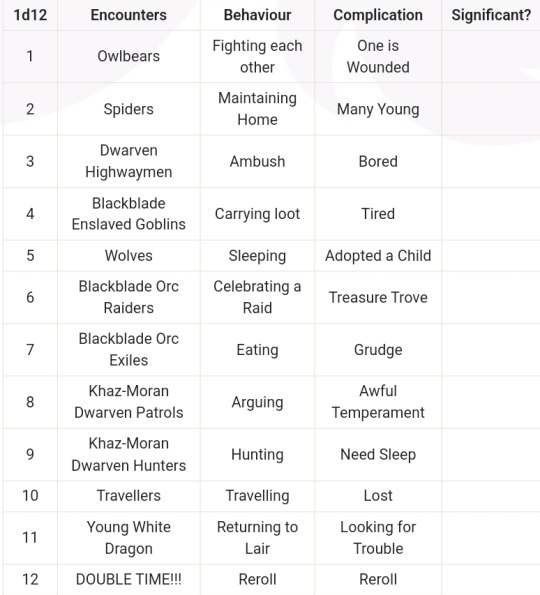
Note how each and everything has its relation in one way or another, but through the sheer variance, they remain truly random and novel.
4. Prerolling and/or Multirolling
Lastly and this is just something that I do, but that I found gamechanging. Be sure to pre-roll 5-7 encounters for each session, for the general area the players are going to be headed in.
Note that you don't need to really prep anything at all, just interpret all of them on a surface level as a buffer.
Also note that you don't need to use all of them if they're not needed. The foreshadowing and signs are worldbuilding and having secrets that the players don't unravel is just as useful as the ones that they do, perhaps even moreso. It adds depth and detail beyond the scope of what the party will encounter
It simply let's you get an idea of the connections between encounters, allows for foreshadowing, and acts as a deterrent to getting caught off guard.
Even if you roll mid-session, I recommend calling for a 5 minute break, rolling 5-7 encounters at the same time and interpreting them and their connections before resuming the session.
It WILL make a difference, trust me
Where to start?
It can be difficult getting inspiration or direction to get started in creating these random encounters, and sometimes you don't want to go through the hassle of thinking them up from nothing
For some great conceptual headstarts and examples for these tables, you can check out 'Worlds Without Number' and it's:
- Page 205 (Great general templates for encounters differentiated by broad creature types such as Beasts and Monsters, Sapient Monsters, and Humans)
- Pages 206-219 (For inspired locations to occasionally run rare encounters or groups of encounters in. This works best with flexible/discovered worldbuilding given the significance of some of these, and you also want to add these in sparingly to keep them significant)
- Pages 246-247 (These pages have great templates for the kinds of encounters and situation to be included in the tables, and it can be expanded vastly, and certain options can be selectively and repeatedly chosen to meet our needs. Mood works well as a complication.)
There might be other pages that are useful as well for these sorts of random encounters in the wilderness that I haven't come across yet. If so, give them a shout out and I'll be sure to add them in. It's worth checking it out in its entirety for some great tips!
Conclusion
Again, credit goes to Dungeon Masterpiece and Worlds Without Number for excellent adjustments. This has been quite long, but I hope you stuck around till the end.
Many a session have been made easy but complex ever since this was introduced and I hope that this helps you out as much as it helped me in my prep and improv!
Feel free to give any advice in formatting on Tumblr, or any feedback on the post itself. It really means a lot to me, thanks!
#dm tools#dungeons and dragons tips#dungeon master tips#dm advice#dm tips#ttrpg#dnd#Youtube#dnd resources#gm tips
94 notes
·
View notes
Text
d66 Ways to Explain This Player Character’s Brief Absence
Aw beans, one of your players couldn’t show up to tonight’s game. Here’s 36 ways to explain why their character is missing just for this session! Roll a d66 (rolling one d6 for the tens-digit and another d6 for the ones-digit) or choose an option that makes sense for your situation.
For brevity, “PC” will be used in place of the missing player character’s name.
11: PC had previously sworn an oath to a wizard they were indebted to, granting the wizard one-time power and authority to temporarily summon PC to them whenever they require their aid. The wizard is cashing in right now.
12: PC found a cursed scroll which temporarily turns them into an incorporeal spirit, forced to haunt the other player characters undetected until they learn some moral lesson the scroll wants them to learn.
13: A faerie spirit on a quest for revenge mistook PC for someone else and stole them away in the night. They’ll return PC once they realize their mistake.
14: The battle of two quarreling chronomancers blew through your location, and PC fell into a time-rift left in the wake of one of the wizard’s attacks, sending them into the (near) future.
15: Aliens abducted PC but will return them when they prove too difficult to contain/experiment on.
16: PC finds themself trapped in a time-loop, and eventually discovers that they only way to escape is to avoid contact with the other player characters for the duration of the loop.
21: PC overheard something the other player characters said about them out of context and misinterpreted it in a way that greatly upset them. They sneak away to abandon the group when no one is looking but return upon realizing it was all a misunderstanding.
22: PC has an important family (or other personal) matter to attend to that requires their swift response, as it involves legal recourse surrounding the disappearance of someone close to them. They will return once it is settled.
23: A scatter-brained wizard’s apprentice studying teleportation magic accidentally switches places with PC, teleporting them to their mentor’s tower an impossible distance away. The apprentice thinks they can figure out a way to swap back with PC if given some time on their own. They hope PC hides in their study until they do – their master tends to fireball intruders on-sight and ask questions later.
24: PC has been possessed by a ghost, who will return control of their body to them once they complete some task the ghost wasn’t able to finish before they died.
25: PC stepped away to refill their water, and got turned around on their way back. They wandered around lost a while, but will find their way to the other player characters eventually.
26: A faerie spirit decided they fancied PC and whisked them away to the faerie realm in an attempt to seduce them. They’ll return PC once they realize they aren’t their type.
31: An enterprising minor demon wants to strike a bargain with PC and teleports the two of them to the top of a tower in an attempt to show off. However, the demon’s pitch is not going well, especially when it’s revealed they lack the power to get them both back down again without resting a while first.
32: PC is called in for jury duty, and either has to serve their time or go to the local magistrate to appeal for a waiver.
33: PC ran into an old friend and went to catch up with them over some drinks. However, the two of them got held up by some of the friend’s newest adversaries.
34: PC is avoiding the other player characters while they prepare a surprise for one or all of them – a gift, or a party to commemorate a certain event like an anniversary or holiday.
35: PC is troubled by recent events – related to the group’s adventures, or external to them – and wants some time alone to clear their head.
36: PC has been haunted by dreams of a symbol in a dark room. They spot this symbol on a stray cat and can’t help but investigate. It seems to be leading them somewhere, but only if they follow it alone.
41: PC is visited by the restless spirit of a friend long gone. Their ghost wants to tell PC a secret – a secret that they must take to their own grave – and leads them away from the rest of the player characters.
42: PC has been struck by sudden inspiration for a work of art, and they simply must bring it into the world before the inspiration fades.
43: PC received an ominous warning from a fortune teller to stay away from [events of today’s session] and is keeping a safe distance just in case.
44: PC is having a crisis of faith in themselves after recent events and takes off on their own for a while until they reassure themselves of their skill. Training montage optional.
45: PC is sent a threatening message by one of their adversaries telling them that if they don’t leave the group, their allies will be made to suffer for it. They leave, believing it to be some heroic self-sacrifice. They return once they realize they are all stronger together, and only with each other’s help can they defeat the adversary’s threat.
46: PC tried to follow an “astral projecting for dummies” guide as a joke, but ended up separated from their body until they figured out how to stop.
51: PC ran afoul of a witch years ago, who tried to curse PC with eternal sleep. However, the witch got their arcane verb-tenses mixed up. So instead, PC was cursed to sleep through a specific date and time. That date is today.
52: PC is shown something that causes them to doubt if their cause is the right one, and leaves until they can find out the truth. They return when what they were shown is proven to be a fabrication by their adversary to mislead them.
53: PC leaves the group because they feel their contributions aren’t appreciated enough. They return after some self-reflection reveals they weren’t feeling unappreciated, they were feeling jealous.
54: PC is feeling extremely ill today. If your group has access to magical disease relief, specify that such relief will still take time to affect whatever sickness has befallen PC – it will just relieve some of the pain in the meantime. Until then, they require rest.
55: PC must take a day off for an important religious observance of their faith.
56: PC received a message from a character they flirted with in town, inviting PC to come visit them for some fun. They sure are taking their time coming back.
61: A minor celebrity from one of PC’s niche interests is going to be in town sort-of-but-not-really nearby, and PC just can’t miss this opportunity to meet them!
62: PC accidentally stumbled into the secret hidden lair of a C-list villain. It will take them a little bit of time to escape on their own.
63: PC saw a rare, elusive mystical beast, prized by many, such as a unicorn. They chased after this once-in-a-lifetime opportunity and will return very disappointed.
64: PC is in a sour mood after accidentally breaking a sentimental keepsake, and just wants to be alone for a while.
65: PC insulted a wizard, who responded by turning PC into a pile of rats. Rats, plural. We’ll have to collect all of them up before they can be changed back.
66: PC is just feeling soooooo eepy. Little nap.
116 notes
·
View notes
Text
After running Dead Beats a couple of times and dealing with the ever-changing numbers during combat, I wanted to make an Excel sheet with a bit of autofill and reminders for my own benefit.
Now I'm looking at it, and trying to get the stuff to work and I question whether I am better off trying to relearn Python and make a little widget for that instead.
How hard could it be?
#python#programming#excel#tabletop roleplaying#tabletop rpgs#ttrpg#gm assistance#gm tools#dead beats rpg#dead beats
5 notes
·
View notes
Text
Trying to figure out what campaigns I would wanna run for a group of covid conscious sapphics is lowkey trying me. I wanna give my potential group several games and campaigns to pick from but I don’t wanna fuck it up cause I haven’t ran a game in a while. I have 1 HB plot for Dungeon Bitches, 3 (1 HB, 2 from the book) for Thirsty Sword Lesbians and 2 (both HB) for Monster Hearts 2e.
Maybe I should just use the safety tool checklist and see what everyone likes?
#monsterhearts#monsterhearts 2e#thirsty sword lesbians#indie ttrpg#ttrpg#queer ttrpg#dungeon bitches#forever game femme 🎲#just gm things#safety tools
8 notes
·
View notes
Text
I am in all things,
Each shade and hue.
Invisible,
Yet visible too.
You only see the surface
When I see you.
A riddle. Probably thought I'd put the answer down here, didn't you. But not yet. If you have a guess stick it in the tags.
24 notes
·
View notes
Text
Project Updates - Aug 6, 2024
Back at it again! I'm hoping to get these devlogs up to at least once a month, if possible, assuming I can keep up this kind of pace with coding. Updates under the cut~
SWN GM Tool
When I decided to update my project list, I said I was moving my old SWN GM Tool down to a sort of backburner status. It felt a bit like the end of an era; the GM tool was my first real personal project that I had started after college and had been poking at it for the last ten years or so, so officially putting it on hold with a desire to come back to it one day was a little interesting.
Especially since I started working on it again that very same week.
I decided to start the whole project over, essentially, and use this as an opportunity to learn to use Godot more at the same time. Within a few days, I had made a simple Faction creation widget as well as a list of factions. In a week, I had a mechanism for saving that faction list to a file and loading it back up as well. All in a simple application made with Godot UI nodes!
I haven't touched the project again in a little over a month, now, but I'm feeling very good about returning and working more on it. Next steps are to make a Faction View scene that shows the stats and assets of the faction, and allows adding and removing assets. Once I feel like I have a good enough user experience for it - something that's not really my specialty - I'll probably upload it to itch.io with just the Faction and asset tracking. After that, I'd like to include a simple map and then a way to run the Faction Turn.
Libtcod Tutorials
Over a year after I received feedback from r/roguelikedev about my attempt at making a C++ tutorial for libtcod, I have begun making a concerted effort to continue working on the codebase again!
After the whole effort of getting a simple eventing system using double-dispatch in place, I took a pretty good break before returning. I decided to make sure the code was working on both Linux and Windows, and updated to the C++23 standard at the same time, which introduced some issues. At first I thought it was a problem with MSVC, but was able to replicate it with Clang as well. It turns out that the way I was doing virtual inheritance for the event handlers worked perfectly fine in C++20, but broke in C++23. Getting that figured out took a few days, but after that I confirmed it worked on GCC, Clang, and MSVC :D
Next I'm going to continue working on the actual tutorial code before I return to writing the tutorials for C++ again, to make sure that there's not more optimizations or architectural changes I'll want to do down the line that would be better to backport again.
3 notes
·
View notes
Text
So, here’s the thing... Your RPG has a character fantasy that it’s trying to play out, right? There’s a flavor that’s going to be baked into the mechanics to try to make it easy for a player to express and be immersed in their character within that fantasy. There is a LOT to discuss on the subject, but I want to zero in on one aspect that can really make or break the fantasy for your players: success and failure.
Whether it’s tests of combat, social, exploration skills, or something else entirely, most RPG systems will determine success or failure by a die roll. It can be a d20, 2d6, 2d20, 1d100, or some truly wild systems with fists full of specialized dice, but we can boil them all down to mathematical probability. Ignoring modifiers and target numbers, if a person needs to roll a 11 or higher on a D20, they have a 50% chance of succeeding. Duh, right? But really think about what that means... In that scenario, the character’s odds of success or failure are even. Do the thing twice, probably fail once and succeed once. A coin toss. It’s just a matter of pure luck at that point. Certainly not something you’d plan on or expect to work!

Contrast that with having to roll a 3 or higher on a d20: 90% chance of success. Solid odds that you’d feel pretty confident with, right? Sure, 10% isn’t that unlikely, but you’d bet on succeeding. You might even expect that to work. You could form a plan around a 90% chance of success. A failure would be a bit of a shock and maybe cause a significant disruption.
Now imagine you only succeed if that d20 shows a natural 20. 5% chance. It ain’t happening, friend. You’re rolling and only divine intervention will save you. Even before the die finishes clattering, you’re expecting and maybe even preparing for the consequences of failure. Should you succeed though... Whole table goes wild. Cheers, backslapping, and probably the formation of a story that you’ll all remind each other of for decades to come.
So what, right? Maybe you’ve never considered the math behind the die rolls, but this is pretty basic stuff! Stay with me for a bit longer as we circle back to the fantasy... Imagine you’re playing a game about spies and you’ve showed up to the table with an expert lock picker. Your character is recognized as an expert in the field, with years of training, experience, and education under their belt. The game starts, and your GM describes a fastfood joint’s general manager’s door in your path as locked by a fairly standard, hardware store quality lock. You get ready to roll to pick the lock, die cool in your hand. The GM gives you the target number... And after doing some basic math in your head, you realize that, even with all of your character’s expertise and tools, your odds of success are 50%. How’s your fantasy feelin’ about then? Do you feel like your lock picking expert is in control of their fate? Or are they at the mercy of the fickle whims of capricious luck? Do you believe in this world where an expert has a coin toss’s odds of defeating this bargain bin lock? I’ll bet not. It’s as ridiculous and jarring as the odds of a 72 year old librarian with aesthma successfully putting a Hell Angel’s biker into an arm-bar hold 90% of the time.
Take a look at the range of difficulties in your game, then compare that with what a typical player character is capable of. What are the odds of their success for a normal or difficult task? Will your experts generally be kicking around that 80-90% chance of success? Or something closer to 50/50? Is there a substantial difference between your experts and untrained characters? This might seem boring, and probably will need the help of a website for dice odds for non-d20 systems, but it is worth the effort I promise you! With this knowledge, you can better craft your game session or system to present the fantasy you want the players to experience.
Here’s a quick and dirty guide:
If players can reasonably reach the 80-90% chance of success for most common tasks, you’re looking at an expert fantasy. Players want to see their character blow through mundane challenges like Superman through a wooden door when their character’s specialization comes into play. This isn’t to say ALL challenges should be simple; far from it! Players crave challenge, particularly for their character’s specialty, so be sure to include situations that will push their character to the limit. If our lockpicking expert is called upon to open up a bank vault in 10 seconds or less, while their allies battle enemy spies the next room over, and the whole mission is on the line, it is perfectly reasonable for the task to be 50/50 odds (or worse!) for the expert and flatly impossible for untrained rubes to attempt. That’s where the expert fantasy shines: difficult tasks with high stakes that only the specialist can possibly succeed.
If most checks for your players are going to be in the range of 40-60%, and doubly so if the difference between an expert and a normal character is minimal, you are in for slapstick or a lot of hot-or-cold rolling. If a magic item requires an Arcana check with a target number of 15 (a hard challenge as the game states), a 1st level genius wizard with training in arcane lore for a total of a +6 bonus to the check and an intelligent fighter with no Arcana training has a +2, that means the wizard needs to roll a 7 or higher and the fighter needs a 13. The wizard has a 70% chance of success while the fighter kicks a 40% chance. The difference between a lifetime of magical study with a genius intellect and some smarter-than-average newbie is 30%. There are, almost certainly, going to be situations where specialist characters will fail a fairly mundane task while their much, much less expert allies will pass.
Short note, I think a lot of 5e’s math problems can be fixed by doubling Proficiency bonuses, increasing harder DCs by 5, and reworking Expertise into something that ignores Disadvantage or grants Advantage more often. I’ll show my work if folks are interested later.
Lastly, if your characters expect failure more than 70% of the time... Whoooo boy, you are doing something weird! Either the game is based on failing-forward mechanics, something where only the truly lucky or exception survive, or dealing with failure is the whole point. Children With Wands is the only game I’ve seen that makes this fun, but I’ve met some truly special individuals who play early editions of Warhammer Roleplaying specifically to gleefully mulch their way through character after character. I don’t judge.
Hopefully this gave you something to think on if you’ve gotten this far. Whatever your fantasy preference, I wish you happy gaming!
#gm tools#RAD New World is squarely in the Expert Fantasy slice if anyone is wondering#so yeah... My biases are showing
44 notes
·
View notes
Photo
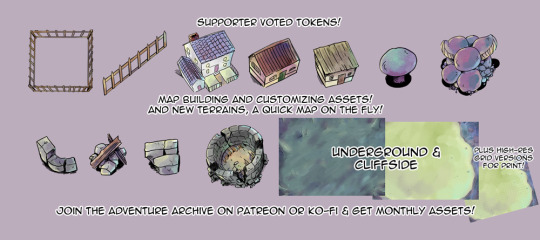
Adventure Archive TTRPG assets for May!
This month's TTRPG assets are up in the Adventure Archive, a collection of ✨377📷 items! Patrons & ko-fi members $5 and up get access to the asset archive for their games & can make monthly requests for ones they'd like added!
https://patreon.com/TriaElf9
https://ko-fi.com/triaelf9
22 notes
·
View notes
Text
i need to get better at understanding how rpg systems work as worldbuilding and why they matter and why we can't just improv it all and how to use them effectively and how to know if it's the fault of the system or me or me not communicating with the players and how to gm better and
#i just need to run more one-shots and other systems ect#source: teddybearsandlightningstorms#brindlewood bay is such a fascinaging concept and i appreciate the worldbuilding etc#i am simply struggling to get players invested and also being a gm and using the system tools also doing things virtual hard
2 notes
·
View notes